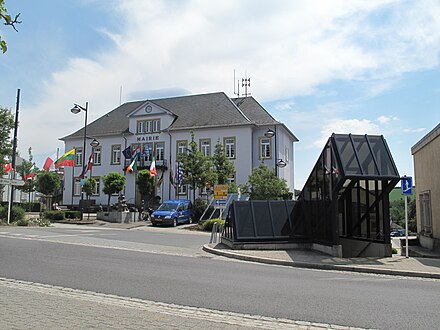Troisvierges - commune in Luxembourg
Troisvierges or Ëlwen as it is known in Luxembourgish, is a commune in the northern part of the Éislek.
Understand
Troisvierges, first mentioned in the fourteenth century, is perhaps known best as the site of the start of hostilities on the western front in the First World War. In August of 1914 the 69th Infantry Regiment of Germany disembarked a train in the town, violating the terms of Germany's use of the railways and violating Luxembourg's neutrality. This meant the start of the occupation of Luxembourg under Germany, which lasted four years until the end of the war.
Most of the town's history is linked to the railways. Around 1900 the majority of the local population consisted of railway and customs employees. Railways such as the Vennbahn, which started in Troisvierges, and is nowadays the reason behind the German enclaves in Belgium, have since disappeared from the town. Like other towns in the north or very south of Luxembourg, Troisvierges has a Portuguese population of around 20%.
Get in
By car
Troisvierges is located along the N12, which runs directly to the nation's capital, located in the south. The N12 crosses the border into Belgium and connects with the A27 (E42) south of Saint-Vith after 15km via the N62.
The town is reachable from the south the quickest over the motorway A7, continuing on the N7 past Diekirch, until turning left on the CR338 through Binsfeld to take the CR337.
From Luxembourg
The N12 starts, as previously mentioned, in Luxembourg City, where it connects to the Boulevard Royal via a small part of the N6 (Avenue Emile Reuter). While this is by far the most straight-forward route to take, using the highways will cut down on your travel time, resulting in roughly an hour of time spent on the road. Simply drive onto the A1 heading for Luxembourg-Findel Airport and Grevenmacher. Use exit 8 to head onto the A7 heading for Ettelbruck. Shortly after the A7 becomes the B7, use the exit to Ettelbruck, heading onto the N7, which you follow into Ettelbruck. Shortly before crossing the Alzette river, take a left onto the N15, followed by a right and a left turn onto the N15 (Route de Bastogne). Just south of Esch-sur-Sûre, the N15 merged with the N12, which you should follow from this point forward, first following directions to Wiltz, followed by Clervaux, continuously following the N12, which eventually will result in reaching Troisvierges.
From Echternach
Travelling from Echternach, use directions to Diekirch, travelling via the N10 along the river Sauer until Reisdorf. To visit Vianden on the way, turn right just after Reisdorf, following the N10 heading for Hoesdorf.
By public transit
Though the Troisvierges Train Station, 50.1194°, 5.9906°. is not as easily reachable from abroad as it used to be, it is still in service on line 10, which connects Luxembourg City with Liège in Belgium. Trains arrive every 30 minutes. Busses do not offer a more varied reach into Luxembourg, connecting most predominantly to Wiltz, from which Bastogne, Esch-sur-Sûre, Clervaux and Ettelbruck are serviced directly. On a local scale, Hautbellain and Huldange, as well as nearby Weiswampach are serviced from the Troisvierges train station. Mind that the line 10 is closed each year for several weeks around August for maintenance. Replacement busses considerably extend the travelling time.
Get around
See
- The region houses the two highest points of the country. Though they're not particularly high by international standards, they do give a good view over the region.
- Kneiff (560 metres), 50.1561°, 6.0408°. 2017-08-01
- Buurgplaatz (559 metres), 50.1625°, 6.0225°. Occasionally mentioned as the highest point of the country, though it is close, it does have the second place to its name. 2017-08-01
Do
Buy
The region is served by a mall located in Wemperhaardt, which is right on the border with Belgium.
- Schopping-Center Massen, 24 Op der Haardt, Wemperhaardt, 50.1488°, 6.0564°, +352 26 901. 2017-08-01
Eat
Drink
Sleep
- Hôtel Restaurant Lamy, 51 Rue d'Asselborn, 50.11376°, 5.98821°, +352 998 041, info@lamy.restaurant. €75 2017-08-01
- Hôtel KEUP, 64 Gruuss-Strooss, Weiswampach, 50.1436°, 6.0708°, +352 99 75 99-1. €89 2017-08-01
- Hotel Wemperhardt, 24 op der Haart, Wemperhardt, 50.1494°, 6.0557°, +352 26 901-501, hotel@wemperhardt.lu. €125 2017-08-01
Campsites
- Camping Walensbongert Troisvierges, Rue de Binsfeld, 50.11931°, 6.00300°, +352 99 71 41, info@camping-troisvierges.lu. 2017-08-07
Connect
Go next
Nearby locations in Luxembourg
- Clervaux — Historical town just south of Troisvierges, featuring a grand castle overlooking the town.
- Vianden — A delightful historic town in the east of the Ardennes. Vianden holds some of everything that the Ardennes have to offer, making it one of Luxembourg's main tourist attractions.
- Wiltz — Historical town to the south, entirely built on a hill with the Wiltz castle in the centre of it all.
Nearby locations across the border
- Bastogne (Belgium) — Like many cities and towns of the Luxembourgian Ardennes, Bastogne played a large role in the Battle of the Bulge.
- Bitburg (Germany) — A small German city known for its beer, beautiful natural scenery, and annual European folk festival.
- Liège (Belgium) — The main city of Wallonia, easily reachable by train via line 10.
Troisvierges
troisvierges.luTroisvierges
2nd-order administrative division
Clervaux
Primary administrative division

